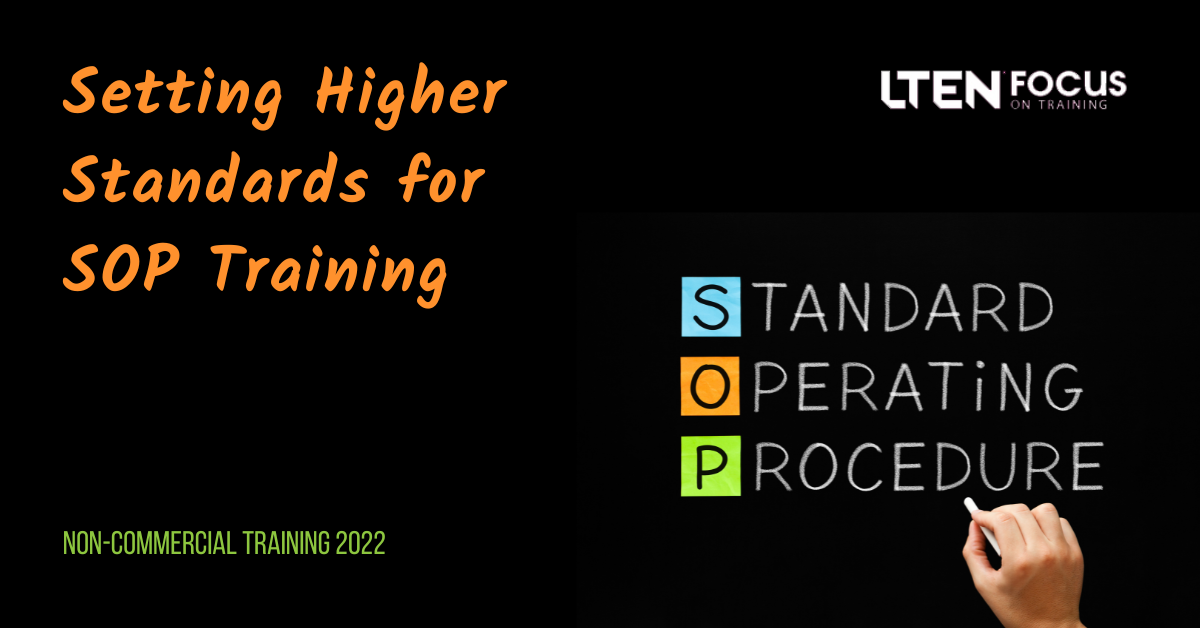
Feature Story – By Laura Last & Karen Snovel
Updating and transforming SOP training provides more effective and efficient onboarding
 An open job position has just filled. One of the first tasks the new employee must perform is to complete the required training.
An open job position has just filled. One of the first tasks the new employee must perform is to complete the required training.
This training often consists of reading standard operating procedures, or SOPs. These SOPs are established or prescribed methods to be followed routinely for the performance of designated operations or in designated situations.
The long list of SOPs is delivered to the new employee, along with a deadline for completion. The training managers breathe a sigh of relief when they receive notification that the employee has completed the requirements and can now begin carrying out their role. The training team has done its due diligence, right? But have they truly set up their newly hired employee to be successful in their new role? Will these critical processes embedded in the SOPs stick with the employee moving forward? Has the training team really ensured compliance?
Innovating Within
BeiGene is a global, science-driven biotechnology company focused on developing innovative and affordable medicines to improve treatment outcomes and access for patients worldwide. We have a vision of transforming the biotechnology industry, creating impactful medicines that will be affordable and accessible to far more cancer patients around the world. The clinical operations group at BeiGene has grown significantly in the past two years, generating a growing need for effective training and development of our employees.
As in most controlled environments, current training practices are centered primarily around compliance. Historically, approximately 100 to 150 learning management system (LMS) courses are required to be completed in the first 30 days of employment, but the curriculum lacks a chronological order to the courses. So, the learner needs to sort through the content themselves to determine which are corporate vs. role-based courses and how best to prioritize them. This can prove to be a confusing and overwhelming process for a new employee at an organization.
An additional challenge with this current system is the content itself. As it is often onedimensional, the learner is left little choice but to read hundreds of text-heavy PDF pages, containing little context as to how the content will relate to their role or to the overarching content within the SOPs. As with many platforms, the learner is provided with little interactivity or application opportunity.
History has shown that learners cannot retain new information after a single exposure. A message needs to be repeated, and in a memorable way, in order to stick.
SOPs Reimagined
Without an agenda to follow or chronological order to the courses, prerequisites for other courses may have been completed at an illogical point in the learning journey. For instance, an SOP might reference a Trial Master File System or Clinical Trial Management System, but the learner has not yet completed any content on either system prior to reading that particular SOP.
 This situation is less than ideal, and it is not unique to BeiGene; it has proven challenging for many organizations over the years.
This situation is less than ideal, and it is not unique to BeiGene; it has proven challenging for many organizations over the years.
The question then remains, how do we balance the necessary compliance requirements with learning that is both interactive and applicable? More so, how do we avoid putting the burden of connecting the dots on the learner and instead provide the learner with a logical journey or story to follow?
The simple answer is that we need to purposefully build it. The desire to have more dynamic training that meets compliance requirements, while not a new concept, continues to be an unmet need industry-wide.
BeiGene made the decision to tackle this challenge head on. With a team of clinical research staff that has doubled in the past year, we made the commitment to update and transform SOP training to provide more effective and efficient onboarding. This will prepare employees to better understand their roles in the process of managing successful clinical trials.
BeiGene knew the curriculum it was envisioning would not only prove crucial for the initial onboarding of employees but would also be available as a reference and refresh point for established employees as well.
Laying Groundwork for Change
Knowing the first step to take is itself a challenge. Our training team at BeiGene reached out to a supplier partner, Syneos, to take this vision and create something tangible — to design a training platform that will tie clinical study SOPs together in an interactive, user-friendly format. Understanding the requirement of maintaining the controlled document SOP training within the validated LMS system, the goal became to create this new curriculum as supplemental training intended to complement the existing curriculum.
With the primary goal of making SOPs more impactful, memorable, and relevant to the user, we implemented several strategies.
Step 1: Review SOPs for Purpose
Thoroughly review each SOP and ask, “Why? Why do we do that?” We want to train with a purpose, and the learner needs to know what that purpose is.
Allow the employees responsible for carrying out the procedures contained within the SOP to review them. This will test whether certain steps and processes are still relevant or if they are outdated. This step will allow for detecting redundancies and eliminating irrelevant and/or outdated information.
Step 2: Look at the Format
Text-heavy documents are the opposite of what we are hoping to achieve here. Consider alternate ways in which large chunks of text can be broken up or replaced by incorporating diagrams, pictures and flowcharts.
Sounds daunting, we know. But think about the long game:
- Visuals take less time to update and are therefore easier to maintain.
- Learners are more likely to commit to memory a process that has pictures to click through, spelling out an otherwise lengthy and confusing process into manageable steps.
- As emotional beings, learners more easily connect and relate to a narrative or story with characters, as opposed to words on a page. Think comic strips calling out the most important content in the SOP in a memorable way; or escape rooms with clues for the next step or knowledge check games where the learner has to put procedure steps in order in an engaging and interactive
manner. - Scenario-based learning for clinical trials could consist of a map where the learner goes in and out of rooms, completing tasks, and checking them off as they move along in the process.
- Allow yourself to get creative. Embed short audio files for auditory learners.
The possibilities are endless. And even those SOPs — yes, you know the ones, where replacing all that text is unrealistic — are deserving of a face-lift. They can be annotated to showcase the most important and role-relevant points, or the training team can create a one-page SOP aid to accompany the document, calling out the most crucial points.
Step 3: Tell a Story
To make the SOPS relevant, memorable and impactful, we determined that it would best support the goals for our organization to set up the many SOPs as if they were chapters in a story.
Each chapter would inform the learner of critical information but would also set the foundation for the additional SOPs to come.
They would answer the reverberating questions of the new employee: “Where does this fit into my role? Which critical points within the SOP can either derail or ensure my success? How can I influence the process to guarantee success? What details or commentary from the experts will help guide my journey?”
In addition to the story, the delivery will immerse the learner within the information and further clarify their role, thereby creating ownership and accountability.
Step 4: Visually Learn
What had traditionally been a passive read will now become an interactive experience through a landing page that shows the learner the entire path and “chunks” up the SOPs into categories, making the journey a visual map before they embark on the first e-learning resource.
The format of e-modules, visual aids and annotated SOPs provides additional perspectives to the training as well as innovative ways to conceptualize the steps and processes within the SOPs. The learner will be engaged, thereby increasing understanding and recall.
The story’s table of contents can serve as a checklist where learners can have the satisfaction of checking something off their list with each completed SOP.
Implementing Change
At BeiGene, we are driven by the power of change. How we work is just as important as the work we do, and we are not afraid to challenge the status quo. The only natural first step to setting higher standards for standards training is to rethink our current SOP for creating and maintaining SOPs.
Laura Last is senior director, global clinical operations, training/knowledge management, for BeiGene USA, and a member of the LTEN Board of Directors. Email Laura at laura.last@beigene.com. Karen Snovel is director, business development & solutions design, for Syneos Health. Email Karen at karen.snovel@syneoshealth.com.








